19th Century Kippah
Every once in a while I blog about something that, I suspect, is interesting to no one but me. And yet, 1,400 monthly visitors prove otherwise. Nevertheless, this may be one of those times.
The question is: What did Jews wear on their heads in America in the early 1860's?
I started, of course, with Wikipedia, and other online articles (most of which were simply copied from Wikipedia). I asked my most Orthodox friend, and he pointed me to Mi Yodea, the Jewish version of StackOverflow. An wesome resource, but didn't give me what I needed.
Why did you need this? For my Civil War living history impression, of course. The character I portray is a Jewish officer in the New York volunteer infantry in 1862. In my regular life, I wear a small leather kippah. It's not usually visible because I usually wear a hat over it, but sometimes the hat comes off. You could say that my self-imposed religious requirement is more important than historical authenticity, but reenactors are actors, after all. If a "real" actor can take off a wedding ring or even (shudder) put on a Nazi uniform, then I should be able do an accurate portrayal of a 19th-century Jews.
Wearing a kippah isn't a Torah-based commandment, you know. Yes, I know, although some Orthodox scholars would disagree. I'm also a Kohen, which complicates things slightly. Ultimately, it is a personal choice, and I choose to wear one. "Why" is a question for another time.
So, what's the answer?
Short answer: It's complicated. In 1860's America, many Jews wore no head covering at all.
Long answer: Like the rest of the world, Judaism in the 19th Century was in a state of flux. The more I study the 19th Century, the more I'm convinced that it was the beginning of the modern era. You have the rise of the modern Jewish concepts, including Reform Judaism, Hassidism, and Zionism. Globalism was starting to affect the movement of people and ideas across the globe. Oh yeah, and a brand new media technology that could capture portraits like never before: photography.
My research method relied heavily on an excellent Wikipedia article: 19th Century rabbis. I figured rabbis would be more likely to wear kippot. What I discovered, sadly, was that most of the 218 articles lacked photographs. These were all great men, who at the very least met Wikipedia's notability standards, but most of them have already faded to words on a page. What a rich history, but most of it has already been forgotten. Still, several dozen had pictures (mostly photographs), so I was able to get an idea of who wore what. There seemed to be a strong correlation between headwear and geographic region, but even stronger was the effect of time. As we neared the 20th Century, more and more rabbis took their kippot off.
Middle East
 Born in 1804, in Bulgaria
Raphael Meir Panigel and Jacob Saul Elyashar were both Sephardic rabbis in Jerusalem, born in 1804 and 1817, respectively. They both wore turbans.
|
 Born in 1805, in Morocco
He wore a turban like his Moroccan neighbors.
|
 Born in 1817, in Israel
|
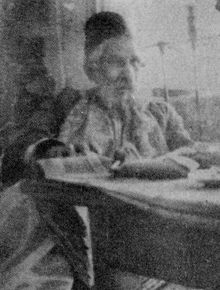 Born in 1820, in Constantinople
Moved to Damascus and then Israel. He wore a Turkish head covering.
|
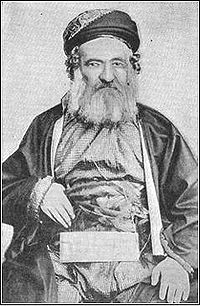 Born in 1822, in Lithuania
Moved to Israel and adopted the local head covering: still a turban.
|
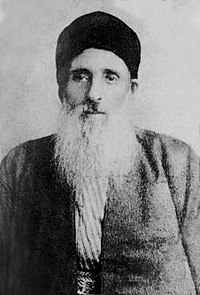 Born in 1825, in Morocco
Also moved to Israel. He wore . . . I can't really tell. It's a large black head covering. Maybe a turban?
|
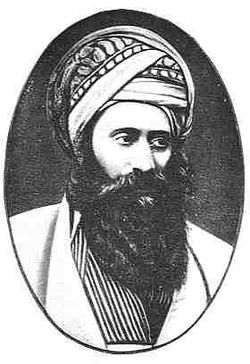 Born in 1832, in Baghdad
Also moved to Israel. I don't know whether that turban is more Iraqi or Israeli.
|
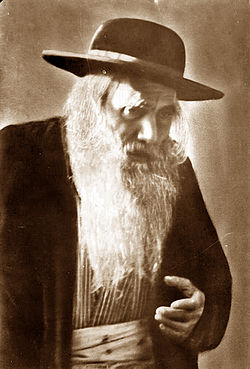 Born in 1848, in Hungary
Moved to Israel and helped found the Haredi community in Jerusalem. He wore a Haredi hat. So, we're already starting to see something that's recognizeably modern.
|
 Born in 1852, in Uzbekistan
Also moved to Jerusalem. He wore a large black kippah that seems much more modern.
|
Eastern Europe
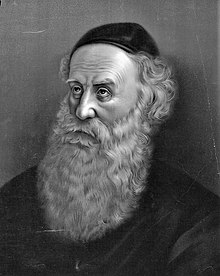 Born in 1745, in Belarus
Interestingly, the oldest picture of a 19th Century Russian rabbi shows a very simple, modern-looking black velvet kippah. I was calling this "modern" when I saw an Uzbeki rabbi wearing it (see above), but maybe this was a regional thing instead.
|
 Born in 1759, in Hungary
Here we see another black velvet kippah, this one from the 18th Century. So the modern-style kippah doesn't seem so much "modern" as "regional." Although it doesn't surprise me that this ended up being the predominant style in America two hundred years later; this is where most American Jews came from.
|
 Born in 1779, in Prague
Rav. Trebitsch wore a tall and large round hat, similar to what was worn in Moscow and also Constantinople. This seems much more typical for Eastern Europe in the late 18th / early 19th Centuries.
|
 Born in 1798, in Krakow
Another large Russian fur hat, reminds me of the Russian Orthodox. Probably not a coincidence.
|
 Born in 1804, in Hungary
Oddly, Rav Ganzfried doesn't appear to be wearing any kind of head covering, in spite of being an Orthodox rabbi and the author of the Kitzure Shulchan Aruch.
|
Born in 1805, in Brody
|
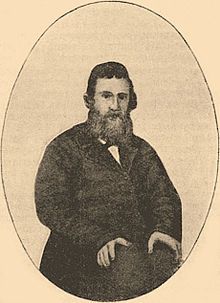 Born in 1809, in Volhynia
Surprisingly, Rav Malbin doesn't seem to wear a head covering either, even though he seems to be considered an Orthodox Rabbi.
|
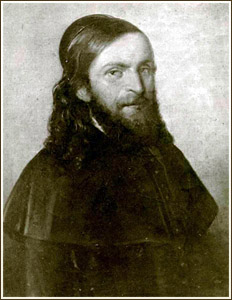 Born in 1811, in Hungary
Rav Low isn't wearing a kippah either.
|
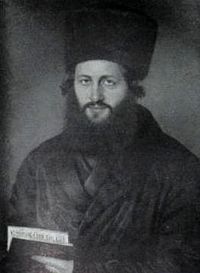 Born in 1815, in Slovakia
Became a leading rabbi in Hungary. He was a contemporary of Rav Low, but unlike Low, Rav Sofer wore a large Russian-style fur hat.
|
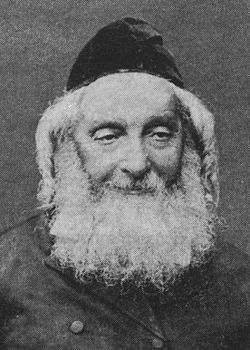 Born in 1816, in Poland
Rav Berlin wore a small, modern-style black velvet kippah, unlike his contemporaries in Hungary.
|
 Born in 1817, in Grodno
He also wore a modern-looking black velvet kippah.
|
 Born in 1821, in Czech Republic
A Kabbalist, he did not wear a kippah. Here we see the trend of "new" branches of Judaism not wearing kippot, a trend that would continue with the early Reform movement.
|
 Born in 1829, in Poland
Another Polish rabbi, here shown wearing a fancy "wheel cap" style head covering. On the wiki article is another photograph of him from much later, in which his head is uncovered.
|
 Born in 1832, in Moscow
Here he's wearing a very Russian-style hat. I don't know if there's a black velvet kippah underneath.
|
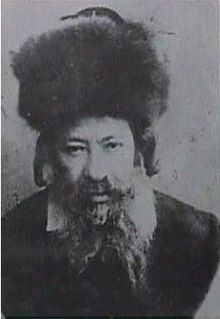 Born in 1837, in Russia
Another Russian rabbi wearing another large fur hat.
|
 Born in 1839, in Hungary
Unlike the earlier Hungarian rabbis, Rav Zussman-Sofer is pictured wearing a smaller, simpler black velvet kippah, much more similar to what was being worn in other parts of Europe. Perhaps it's because he's a generation younger.
|
 Born in 1841, in Prussia
Another "wheel cap" style head covering. Head coverings seem to vary widly between different countries in Eastern Europe.
|
Born in 1841, in Belarus
Another large black cap, somewhere between the Russian-style fur cap and the more European style black velvet kippah.
|
 Born in 1843, in Slovakia
|
 Born in 1845, in Lithuania
I'm starting to notice a division: Jews from Southeastern Europe were more likely to wear large head coverings, and jews from Northeastern Europe were more likely to wear a small black velvet kippah, or nothing at all.
|
 Born in 1850, in Ukraine
The Hassidic rabbi wore an Hassidic hat.
|
 Born in 1850, in Hungary
Rav Sofer continued the trend of younger Hungarian rabbis wearing kippot instead of larger head coverings. He died at Auschwitz.
|
 Born in 1858, in Belarus
Another Belarussian Jew, Rav Rogatchover did not wear a kippah either.
|
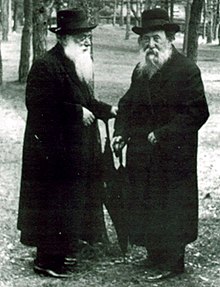 Born in 1863, in Belarus
Shown here wearing a Hassidic-style hat, even though he was not a Hasid. I'm wondering if he's simply wearing it because it's cold outside, and I wonder what he has on underneath (if anything).
|
Northern Europe
|
Born in 1762, in Germany
Moving back to the late 18th century in Germany, we see Rav Sofer wearing the same large fur hat as other Jews of the early 19th century.
|
 Born in 1782, in Germany
This hat seems much more similar to the smaller black velvet kippot that would sweep Europe later on.
|
 Born in 1790, in Austria
Shown here wearing a small black velvet kippah, he was also painted wearing a large Russian fur hat. This makes me wonder whether there wasn't a greater variation among all rabbis in the 19th century. My data is too limited.
|
 Born in 1796, in Amsterdam
The only rabbi with a portrait from Amsterdam. Goodness, I hoep this isn't what Dutch Jews wore. Frankly, his hat doesn't look Jewish at all, although I'm not sure the Russian fur caps or turbans do either.
|
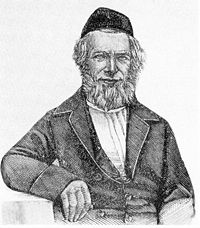 Born in 1798, in Germany
Another small black velvet kippah, so typical of the mid-19th century. I think I'm starting to see the answer to my original question.
|
 Born in 1808, in Germany
Rav Hirsch had "considerable" influence on modern Orthodox Judaism. And he wore a small black velvet kippah.
|
 Born in 1810, in Amsterdam
Another tricorn hat. I hate to say it, but I think this is what Dutch Jews wore.
|
 Born in 1829, in Germany
Rav Kayserling followed the late 19th Century practice of not wearing a head covering at all.
|
 Born in 1831, in Germany
An Orthodox rabbi, Rav Lehmann fought against the growing Reform movement. He continued to wear a black velvet kippah even when some of his contemporaries did not.
|
 Born in 1850, in Austria
Considered an Orthodox rabbi, he nevertheless did not wear a kippah.
|
 Born in 1859, in Austria
Rav Deutsch emigrated to the United States in 1891 and got himself in trouble for his politics during WWI. Like his contemporaries from late 19th century Austria, he also did not wear a kippah.
|
Western Europe
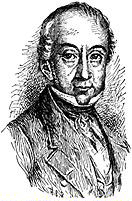 Born in 1784, in Italy
As we enter Western Europe, we see that Jews are less likely to wear kippot, even at the beginning of the 19th Century.
|
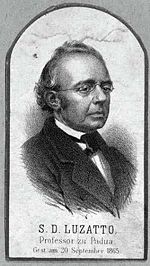 Born in 1800, in Italy
|
 Born in 1802, in France
|
 Born in 1803, in Germany
Even though he was born in Germany, Rav Adler became the Chief Rabbi of the British Empire. Unlike his Western European bretheren, he wore a fancy "wheel cap" style hat, similar to those worn in Southeastern Europe. But I suspect this has more to do with the British prediliction for fancy hats.
|
 Born in 1820, in Hungary
Born in Hungary, Rav Schiller-Szinessy became a professor at Cambridge. The only photo of him I could find shows him wearing a graduation cap. I'm guessing it was not his everyday hat.
|
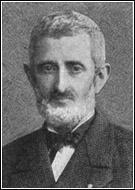 Born in 1822, in Italy
A kabbalist, he did not wear a hat. But neither did most of his Italian contemporaries.
|
 Born in 1839, in France
Rav Kahn was the Chief Rabbi of France. Unlike his contemporaries in England, he did not wear a hat.
|
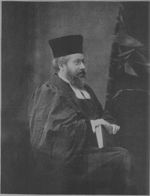 Born in 1839, in Germany
Another German-born Chief Rabbi of the British Empire, he wore a fancy hat like his predecessor in England.
|
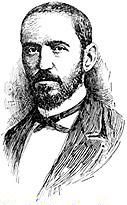 Born in 1839, in France
Another Western European rabbi with no kippah.
|
America
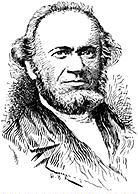 Born in 1800, in Germany
Rav Rice immigrated to the United States in 1840 and became the first ordained rabbi to serve in a rabbinical position in the US. Although the small black velvet kippah was still common in German in 1840, Rav Rice did not wear one.
|
 Born in 1823, in Italy
Rav Morais immigrated to the United States in 1851, and helped found the Jewish Theological Seminary in New York, immediately after the American Civil War.
|
 Born in 1823, in Italy
Rav Morais immigrated to the United States in 1851, and helped found the Jewish Theological Seminary in New York, immediately after the American Civil War. A major influence on Conservative Judaism, he did not wear a kippah.
|
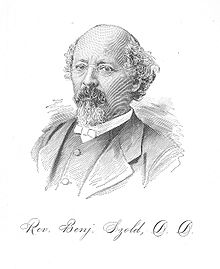 Born in 1829, in Hungary
Rav Szold immigrated to the United States in 1859.
|
 Born in 1842, in Hungary
A Conservative Jew who opposed Reform Judaism, he nevertheless did not wear a kippah. He immigrated to the United States in the 1880's.
|
 Born in 1843, in Germany
Rav Kohler immigrated to the United States in 1869 and helped build the foundation for Reform Judaism. It is not surprising that he does not wear a kippah; what is surprising is that none of this more conservative colleagues did either. This is often held up as one of the things that made Reform Judaism different, but I don't see much evidence for Orthodox or Conservative Jews wearing kippot in 1860's America.
|
 Born in 1845, in Russia
Rav Schochet immigrated to the United States in 1906. In the photograph it looks like he's wearing a Russian fur cap, but this probably has more to do with the fact that he was from Russia and not Europe.
|
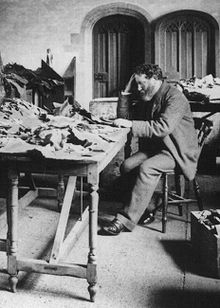 Born in 1847, in Romania
Rav Schechter immigrated to the United States in 1902 and became president of the JTS.
|
Born in 1866, in Russia
Rav Risikoff immigrated to the United States in 1906. He seems to conform to the trend that the only rabbis in America who wore head coverings were the ones from Russia.
|
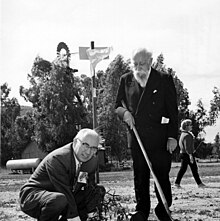 Born in 1878, in Germany
Rav Sonderling was a Field Rabbi in the German army before immigrating to the United States in 1923. He co-wrote a siddur in the 1940's. None of the authors of the siddur wore kippot.
|
The Chaplaincy
 But perhaps there's an even better source for what Jews wore during the American Civil War. The Unitd States Army Chaplain Corps allowed Jews into the chaplaincy beginning in 1862. Rabbi Arnold Fischel was one of the first rabbis to be commissioned as a chaplain in the US Army. A Dutch American, he did not wear a kippah.
But perhaps there's an even better source for what Jews wore during the American Civil War. The Unitd States Army Chaplain Corps allowed Jews into the chaplaincy beginning in 1862. Rabbi Arnold Fischel was one of the first rabbis to be commissioned as a chaplain in the US Army. A Dutch American, he did not wear a kippah.
Here's a drawing of an Army chaplain leading Jewish services during the Civil War. Of course, we don't know for sure that that's a chaplain. It could just be a coincidence that the hazzan is an officer. Nevertheless, the picture shows everyone wearing kippot, at least during services.
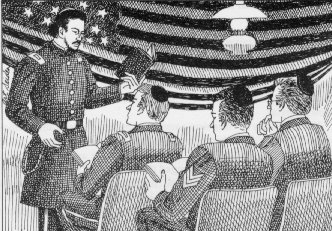
Conclusion
I hate to say it, but it looks like the person I'm portraying probably did not wear a kippah, at least not on an everyday basis. Given that most prominent Jews in America were still immigrants, and given that a good deal of Jewish immigrants were already coming from places that still wore kippot (mostly Eastern Europe), it's not much of a stretch to say that he could have worn a black velvet kippah, at least when he wasn't wearing his military cap. He certainly wouldn't have worn a small leather kippah like I do in "real life." I would feel uncomfortable giving up the kippah entirely, so I may just get myself a black velvet kippah specifically for reenacting. It would have been unusual, but frankly I'm the only Jew I know who wears a kippah every day. (I know there are communities where everyone wears one, but I'm not part of one of those communities.) It's okay to be unusual, as long as the portrayal is historically accurate.
Bottom line: a Jewish officer in the American Civil War would have probably not worn a head covering other than his military cap, and if he did, it probably would have been nothing more than a plain black velvet kippah.
- Log in to post comments
